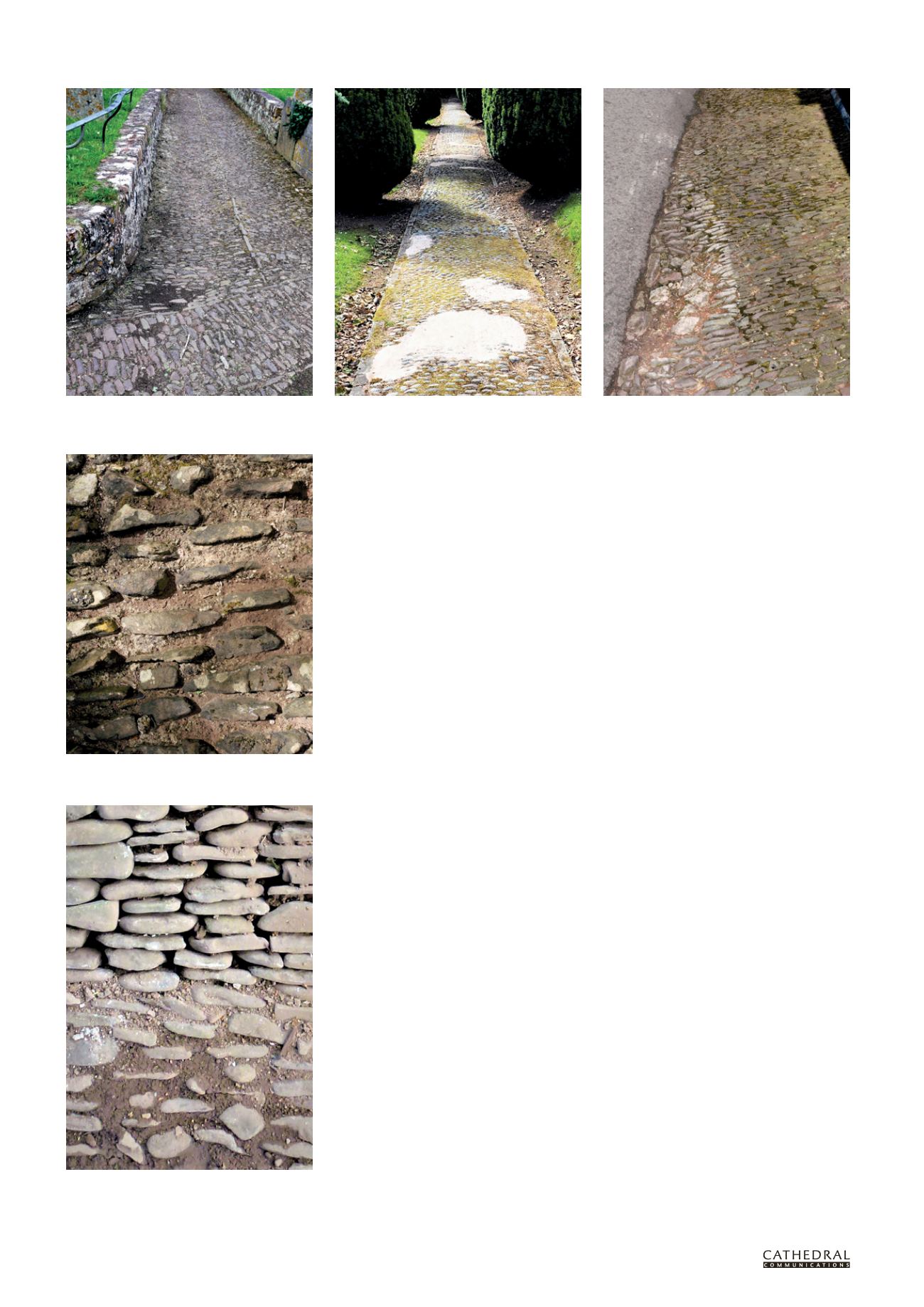

38
BCD SPECIAL REPORT ON
HISTORIC CHURCHES
24
TH ANNUAL EDITION
Plants removed from cobble revealing a worn
original earth mortar infill
Appearance
– make the solution honest
but aesthetically neat or invisible: there is
no justifiable reason why modern repairs,
once aged, should not add character and
appeal in the same way as historic ones.
Traditionally, cobbles were laid in
non-porous subsoil, especially clays, and
it is generally best to copy what went
before. Often some coarser binder was
added, such as a local sand or grit. More
recently lime (or sometimes cement)
mortars have been used but they are not
recommended unless vehicles will be
using the area. The original materials were
probably sourced locally so it is best to
try to find matching cobbles and subsoil
locally too if possible. Patterns or even
lettering were often formed in cobbles
by laying stones of the same or similar
types in different directions, or by using
different colours or types of stone. These
may not be immediately obvious, so when
relaying cobbles it is important that each
one is placed back in the ground in the
same orientation as before.
Sourcing appropriate cobbles is
the most difficult and time-consuming
aspect of cobble repairs, and is best
done before any work commences. Many
traditional cobbled areas are made from
flat-topped cobbles, which were usually
found in local streams and river beds.
The stones were flattened and smoothed
uniquely over the centuries by the
passing of water, silt and other material.
They were placed with the flattened side
on show. Rounded cobbles, which are
commonly found on beaches where they
are shaped by being washed up and down
and tumbled by the waves, should not be
used as a substitute. Bear in mind that
those dug from the ground may also have
been formed on beaches, many millennia
ago. They are not the same as river-worn
cobbles. Consequently it is important to
try to source the cobbles from a similar
place to the originals.
River cobbles can no longer be
extracted in this country, and the cobbles
which are available from quarries are
usually rounded beach-type cobbles.
The best solution is to find cobbles
salvaged from earlier schemes. Local
authorities used to store the cobbles
which were extracted from culverts or
when relaying roads, but few still do
so, and specifiers may find themselves
passed from pillar to post in the
hope of finding mythological depots.
Private estates are more likely to retain
cobbles from similar sources, although
finding the shapes and sizes required
may involve a great deal of sorting.
Cobbles were traditionally set into
rammed subsoil which was laid for
the purpose in the area to be cobbled.
The stones were set into the subsoil by
hammering them home so that they were
touching adjacent stones. Additional
bedding material was packed between the
touching stones to help to stabilise them,
and longer stones were hammered deeper
to further improve the key and prevent
movement. Usually, these ‘peg-stones’ are
distributed fairly evenly across the scheme,
but in some places all the stones are found
to be peg-shaped and hammered in deeply.
The process is rather like building
a stone wall on its side and the bedding
material is like the mortar. The tools are
simple and include hammers of various
sizes, shapes and materials to knock the
stones into place evenly. A large mallet
and a timber board are particularly useful.
Spades and a crow-bar also come in handy,
initially to prise stones from position and
later, to back-fill the substrate between
the stones. A string-line is used to help
Cobbles partially backfilled with sub-soil, showing
the flat-topped form of reclaimed river-worn cobbles
St Swithuns, Sandford, Devon: some areas have sunk
and collect water, but otherwise this section is in
good repair
Ugly concrete infill and cement repairs
Another inappropriate repair using mismatched
stones


















